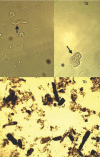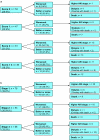Urine microscopy is associated with severity and worsening of acute kidney injury in hospitalized patients
- PMID: 20089493
- PMCID: PMC2827582
- DOI: 10.2215/CJN.06960909
Urine microscopy is associated with severity and worsening of acute kidney injury in hospitalized patients
Abstract
Background and objectives: Serum creatinine concentration at the time of nephrology consultation is not necessarily indicative of the severity of acute kidney injury (AKI). Although urine microscopy is useful to differentiate AKI, its role in predicting adverse clinical outcomes has not been well described.
Design, setting, participants, & measurements: The relationship between urine microscopy findings at the time of nephrology consultation for AKI and clinical outcomes was evaluated prospectively. A urinary sediment scoring system was created on the basis of the number of renal tubular epithelial cells and granular casts. The primary outcome was worsening of AKI (progressing to higher AKI Network stage, dialysis, or death) during hospitalization.
Results: Of 249 patients consulted for AKI, 197 had acute tubular necrosis or prerenal AKI and were included in the analysis. At consultation, 80 (40%) had stage 1, 53 (27%) had stage 2, and 66 (33%) had stage 3 AKI. The urinary sediment combined scores were lowest in those with stage 1 and highest in stage 3 AKI. Seventy-nine patients (40%) experienced worsening of AKI from the time of consultation. The urinary scoring system was significantly associated with increased risk of worsening AKI (adjusted relative risk: 7.3; 95% confidence interval: 4.5 to 9.7 for worsening with score of > or =3 versus score of 0) and was more predictive than AKI Network stage at the time of consultation.
Conclusions: The urinary sediment score may be a useful tool to predict worsening of AKI due to either acute tubular necrosis or prerenal AKI during hospitalization.
Figures



Comment in
-
Is it time to evolve past the prerenal azotemia versus acute tubular necrosis classification?Clin J Am Soc Nephrol. 2011 Oct;6(10):2332-4. doi: 10.2215/CJN.08570811. Epub 2011 Sep 15. Clin J Am Soc Nephrol. 2011. PMID: 21921150 Free PMC article. No abstract available.
References
-
- Perlmutter M, Grossman SL, Rothenberg S, Dobkin G: Urineserum urea nitrogen ratio; simple test of renal function in acute azotemia and oliguria. JAMA 170: 1533–1537, 1959 - PubMed
-
- Miller TR, Anderson RJ, Linas SL, Henrich WL, Berns AS, Gabow PA, Schrier RW: Urinary diagnostic indices in acute renal failure: A prospective study. Ann Intern Med 89: 47–50, 1978 - PubMed
-
- Bock HA: Pathophysiology of acute renal failure in septic shock: From prerenal to renal failure. Kidney Int Suppl 64: S15–S18, 1998 - PubMed
-
- Klahr S, Miller SB: Acute oliguria. N Engl J Med 338: 671–675, 1998 - PubMed
Publication types
MeSH terms
Grants and funding
LinkOut - more resources
Full Text Sources
Other Literature Sources
Medical

